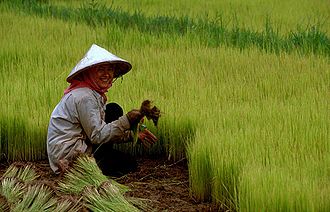In Suffolk, on the East coast of the UK, broom is a native plant. It doesn't appear to be invasive here, and in fact is sold in garden centres. The soil there is about as sandy as you can get, with scarcely any topsoil. I came across
this website which details ancient botanical uses. I love the description "And is a shrub that growyth in a place that is forsaken, stony and untylthed. Presence thereof is witnesse that the ground is bareyne and drye that it groweth in. And hath many braunches knotty and hard."
I think there having something which thrives despite the poor soil is considered to be an advantage. I would imagine that the only way to control it would be to improve the soil.
Further, the website gives these uses:
"The Broom has been put to many uses. When planted on the sides of steep banks, its roots serve to hold the earth together. On some parts of our coast, it is one of the first plants that grow on the sand-dunes after they have been somewhat consolidated on the surface by the interlacing stems of the mat grasses and other sand-binding plants. It will flourish within reach of sea spray, and, like gorse, is a good sheltering plant for sea-side growth.
Broom is grown extensively as a shelter for game, and also in fresh plantations among more important species of shrubs, to protect them from the wind till fully established.
The shrub seldom grows large enough to furnish useful wood, but when its stem acquires sufficient size, it is beautifully veined, and being very hard, furnishes the cabinetmaker with most valuable material for veneering.
The twigs and branches are serviceable not only for making brooms, but are also used for basket-work, especially in the island of Madeira. They are sometimes used in the north of England and Scotland for thatching cottages and cornricks, and as substitutes for reeds in making fences or screens.
The bark of the Common Broom yields an excellent fibre, finer but not so strong as that of the Spanish Broom, which has been employed from very ancient times- it is easily separated by macerating the twigs in water like flax. From the large quantity of fibrous matter contained, the shoots have been used in the manufacture of paper and cloth.
Tannin exists in considerable amount in the bark, which has been used in former times for tanning leather.
Before the introduction of Hops, the tender Freen tops were often used to communicate a bitter flavour to beer, and to render it more intoxicating.
Gerard says of the Broom:
'The common Broom groweth almost everywhere in dry pastures and low woods. It flowers at the end of April or May, and then the young buds of the flowers are to be gathered and laid in pickle or salt, which afterwards being washed or boiled are used for sallads as capers be and be eaten with no less delight.'
Broom buds were evidently a favourite delicacy, for they appeared on three separate tables at the Coronation feast of James II."








